Want to view the natural beauty along the Qinghai-Tibet Railway but dislike too long train journey? This tour is what you need. Firstly, after your panda time and exhilarating experience in Chengdu, you will get to Xining by flight. Then spend 2 days to explore the beautiful Qinghai Lake and Taer Monastery. Before arriving in Lhasa by train and visiting the famous religious sites, you will have fantastic plateau views on the railway.
Highlights of this tour:
- Experience the relaxing lifestyle of Chengdu and have a close contact with the adorable giant panda;
- Ride a traditional Chinese train to Tibet on the highest railway in the world - Qinghai-Tibet Railway;
- Climb up the grandiose Potala Palace and visit sacred Buddhist temples and monasteries in Lhasa, such as Jokhang Temple, Drepung Monastery etc.;
- Go to explore the holy lake as well as one of the most beautiful lakes in China - Namtso Lake.
Tour Brief Information
- Tour price: from
- Tour code: TD-CXL-10
- Tour Type: Private escorted tour with Tibetan tour guide and private vehicle with experienced driver
- Destination: Chengdu / Xining / Lhasa
- Duration: 10 days 9 nights
- Departure: Flexible
- Travel Theme:





- Best Time:


- Physical Level
- Tour Pace
- Max Altitude
5,068m
- Itinerary Details
- Price Guide & Booking
- Trip FAQs
- Reviews
- Make an Enquiry
Your tour - at a glance
Day 1~2 Arrival & Chengdu Tour
Day 3~5 Xining Tour & Train to Lhasa
Day 6~8 Lhasa Arrival & Lhasa City Tour
Day 9 Lhasa - Namtso Lake - Lhasa
Day 10 Lhasa Departure
Itinerary Details - Day by Day
Day 1 Chengdu Arrival
Welcome to the hometown of Giant Panda! Upon arriving at the airport/train station, you will be met by your local tour guide, and then drive to your downtown hotel in Chengdu City. After the hotel check-in, you are free to take a rest or explore around on your own.
Optional Activity: go to enjoy an authentic Sichuan Cuisine dinner at a local restaurant.
Day 2 Chengdu ( B, L )
Chengdu has three famous features - Giant Panda, History and Leisure Living Pace. Today, you will go to explore these tree features one by one. First is to visit the lovely Giant Pandas in Chengdu Research Base of Giant Panda Breeding, which is the No. 1 thing to do in Chengdu. You will leave your hotel early and drive about 30 minutes to the panda base so that you can catch up the great moments of pandas, such as feeding, playing, climbing tree, etc. There are different enclosures for pages of different ages, such as all around to see baby pandas, 1 year-old pandas, teenage pandas, and older pandas. Beautiful walking paths will lead you to visit the enclosures from one to next. Enjoy the happy time with pandas.
The second place to visit is the sacred Wenshu Temple which is hidden peacefully among the modern mansions. This temple is the most popular Buddhist temple in Chengdu region. It has beautiful traditional ancient architecture. The atmosphere is calm and quiet, some people are praying. There is a little garden and the monastery is very colorful and decorated.
Lastly, you are going to explore the leisure living peace of locals at Renmin Park and Jinli Street. Renmin Park, or People’s Park is the place for locals to go for a relaxing walk, meet friends, or have a cup of tea. While Jinli is the “street of tourists”. You can wander on the traditional old street to absorb the special atmosphere of Chengdu, taste local snacks, watching a performance, etc.
Optional Recommended Night Activity: watch an fascinating show of traditional Sichuan Opera & Face Changing Performance in a local theatre.
-
 Adorable pandas are whispering
Adorable pandas are whispering
-
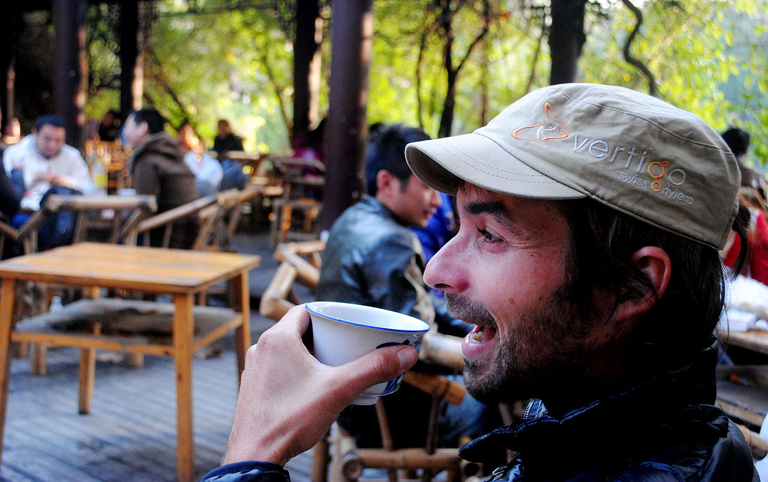 Drink a cup of tea in Renmin Park
Drink a cup of tea in Renmin Park
-
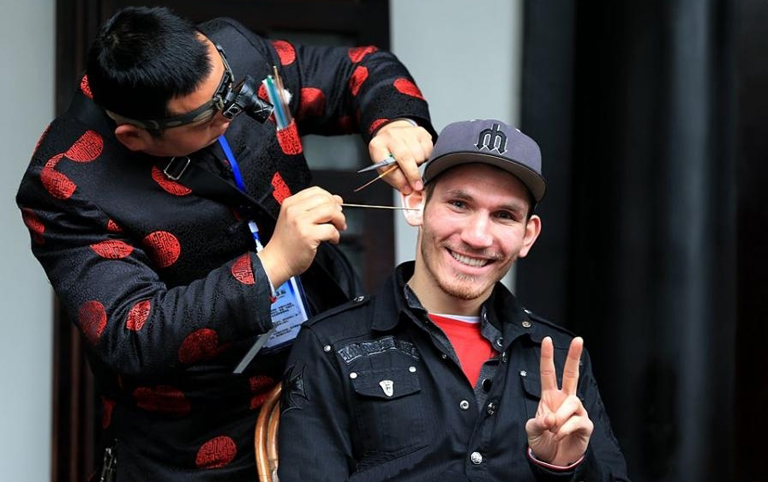 Enjoy traditional Ear Treatment
Enjoy traditional Ear Treatment
Day 3 Flight to Xining from Chengdu ( B )
Today, you will visit the Dufu Thatched Cottage which is a museum in honor of Dufu (712 -770 AD), who was the greatest realist poet and has been famed as the Sage of Poetry.
After lunch, your tour guide will escort you to the airport for your flight to Xining.
-
 Dufu Thatched Cottage - Former Residence of China's Poet-Sage
Dufu Thatched Cottage - Former Residence of China's Poet-Sage
Day 4 Xining ( B )
After breakfast, drive around 2.5 hours to the Qinghai Lake which is the best highlights of your Qinghai tour.
Qinghai Lake is surrounded by high mountains from outside. And on the foot of mountains it is endless beautiful grasslands. So you can enjoy the great views by walking, riding or biking. Qinghai Lake is the paradise for birds, which can amount to more than 10 thousand in the summer.
Cruise on the lake and visit the Bird Island in the lake. On route, you will also visit the Riyue Mountains (Sun and Moon Mountains) and the Ri Pagoda and Yue Pagoda which hich were built in Tang Dynasty to commemorate the intermarriage of marrying Princess Wencheng of Tang to Tubo. In nearby, you will also be amazed by the Daotang River which flows oppositely.
Go back Xining and stay overnight.
-
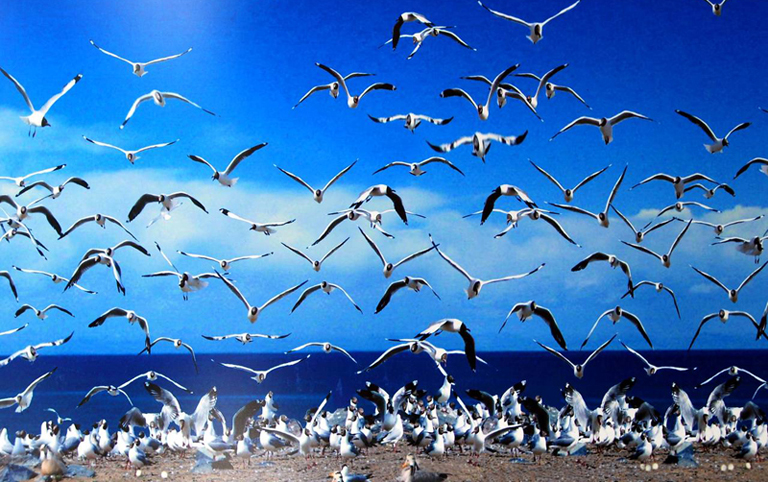 The Paradise of Birds
The Paradise of Birds
-
 Riyue Mountain - Sun Mountain & Moon Mountain
Riyue Mountain - Sun Mountain & Moon Mountain
Day 5 Train to Lhasa ( B )
After breakfast, drive about 26km to visit the famous Taer Monastery.
Taer Monastery is the birthplace of the Tibetan Buddhism master – Tsongkhapa who was the founder of Gelug(a sect of Buddhism). It is also famous as one of “Six Gelug Monasteries”. You must not miss the “three bests” of Taer Monastery – murals, barbola and butter sculptures. Taer Monastery is also a very important institute to learn Buddhism, Astronomy and Medicine. There are many Buddhist ceremonies organized here in each year.
Get back to Xining city for the train to Tibet. Enjoy the fantastic plateau views along this highest railway in the world.
-
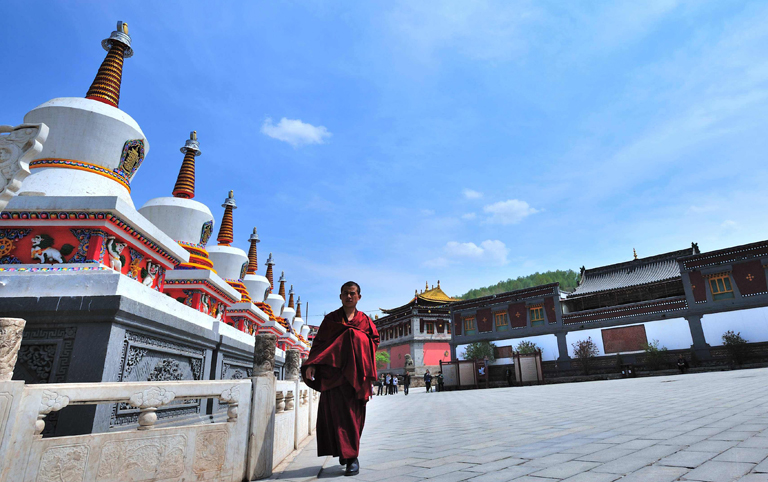 Pagodas of Buddha Shakyamuni in Taer Monastery
Pagodas of Buddha Shakyamuni in Taer Monastery
Day 6 Lhasa Arrival ( B )
Witness the beautiful Tibetan Plateau with groups of nomads. See the Kekexili Nature Reserve which protects wild plants and animals as well as their natural habitates.
Once arrival at Lhasa, you will be picked up by local tour guide at the train station, then be escorted to your hotel in Lhasa city in a private vehicle.
After arrival at your hotel, the rest of the day is free for you to explore the local areas and acclimatize yourself to the air, temperature and high altitude of Lhasa.
High Altitude Acclimation Tips:1) go for some leisure walking to acclimate the high altitude but avoid strenuous activity after arrival; 2) you'd better not have bath, in case of catching a cold; 3) drink more water, and have some fruit; 4) have a good rest.
-
 You will have a unforgettable journey with Qinghai-Lhasa Railway
You will have a unforgettable journey with Qinghai-Lhasa Railway
Day 7 Lhasa ( B )
Start today’s Lhasa exploration with an exciting visit to the landmark - Potala Palace which is regarded as one of the most beautiful architectural building in the world. You will climb up the palace along the zigzag stone paths with white-and-red walls to the top of the palace where you can not only appreciate the exotic Tibetan-style architecture, but also get a great view of Lhasa’s urban areas, then walk into the inner space of Potala Palace to explore the stately chapels and learn about the history of the palace.
Continuing your exploration, you will then get to Jokhang Temple which is considered as the spiritual heart of Tibetan Buddhism. Each day, there are thousands of pilgrims coming from different places in Tibet to the temple to worship to the Buddha. This temple is also known as the “house of Buddha” because it keeps the precious Jowo Rinpoche, the life-sized (5 foot/1.5m) image of the Shakyamuni at the age of 12. The last site for today’s exploration is the famous Barkor Street. It is a circular and wide street encircling the Jokhang Temple. The local people like to walk on the street for several circles usually in the late afternoon as a daily tradition of pilgrimage. The street also has many shops selling a wide variety of traditional Tibetan goods, religious items and handcrafts.
Tips of today: 1) there are 1,080 steps up to climb to the top of Potala Palace, so don’t walk in a rush, which may cause high altitude sickness; 2) taking photos is not allowed inside the palace; 3) today you will be mainly outside, please bring some water, a hat, sun cream, and sun glasses with you.
-
 Admire the amazing appearance of Potala Palace
Admire the amazing appearance of Potala Palace
-
 Jokhang Temple Exterior
Jokhang Temple Exterior
-
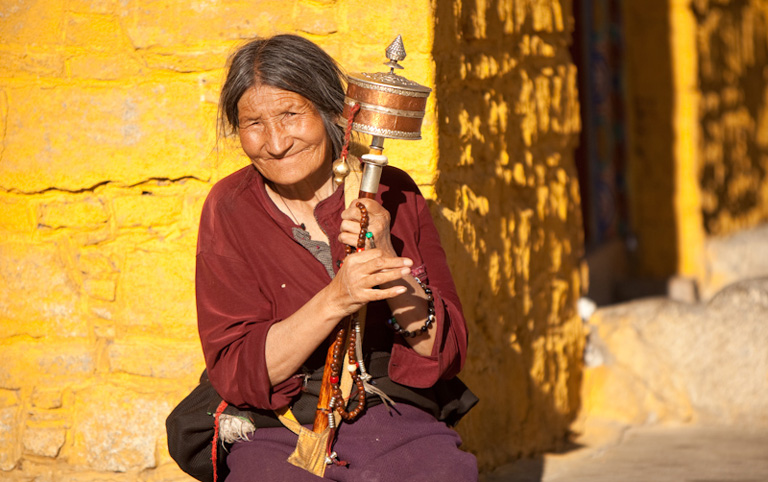 Old Tibetan Lady Welcomes with Smiles
Old Tibetan Lady Welcomes with Smiles
Day 8 Lhasa ( B )
After breakfast, you will firstly go to visit the beautiful Norbulingka which used to be the former summer palace of Dalai Lamas in the ancient time, and now is a public park. It is famous for its Potrang, the private palaces of former Dalai lamas with grandiose Tibetan architecture style. Next, drive several kilometers to the western outskirts of Lhasa to visit Drepung Monastery. Drepung, in Tibetan, means “prosperity”. Since its establishment, Drepung Monastery has always been one of the most important Buddhist monasteries in Tibet. In its heyday, there were more than 10,000 monks lived and studied in the monastery. Throughout its history, many important and famous Tibetan leaders used to study here, especially the Dalai Lamas. So Drepung Monastery is also respectfully known as the “Mother School of Dalai Lamas”.
In the afternoon, you will be taken to another famous monastery in Lhasa - Sera Monastery. It is famous for the spectacular “Buddhism Debating”. As a daily routine, the monks gather in a courtyard, and debate on the Buddhist doctrines with supplemented gestures, which is thought to be helpful to facilitates better comprehension of the Buddhist philosophy to attain higher levels of study. After enjoying the "Buddhism Debating", you will be transferred back to the city. The rest time is your own free time to rest.
The Etiquette of Visiting Monastery: 1) you shouldn’t wear short and uncover shoulders; 2) taking off your sunglasses and hat before entering the chapels; 3) taking photos is usually not allowed inside the chapels.
-
 Courtyard for Buddhism Debating in Sera Monastery
Courtyard for Buddhism Debating in Sera Monastery
-
 Monks Gathered at the Entrance of Drepung Monastery
Monks Gathered at the Entrance of Drepung Monastery
-
 Norbulingka Park is a good summer resort in Lhasa
Norbulingka Park is a good summer resort in Lhasa
Day 9 Lhasa – Namtso Lake ( B )
Want to explore some other features of Tibet instead of the monasteries? Let's take an exciting trip to the holy lake Namtso which is about 5 hours driving from Lhasa City. You will arrive at Namtso Lake around the early afternoon. Take some rest and throw yourself into the incredible landscape of holy lake.
Namtso Lake is the highest saltwater lake in the world with an altitude of 4718 meters, also the second largest saltwater lake in China (after the Qinghai Lake). It’s quite common for tourists who are awestruck at the Namtso at the first sight. With the snowy mountains in the background, the crystal-clear dazzling blue water, Namtso is stretching to the horizon. In clear days, the lake looks like a beautiful turquoise surrounded by magnificent snow-capped Tanggula Mountains, and the lakeshore is green, wide and open, dotted with tents, yaks and sheep of local nomads. For travelers, Namtso is the ideal place for photography, while for Tibetans, it is a scared and magical lake for pilgrimage.
Lastly, drive back to Lhasa for accommodation.
Tips of today: 1) the altitudes of Namtso Lake region is about 5, 000 meters, so you should be fully prepared for high altitude sickness. Do remember to keep warm all the time and avoid strenuous activity; 2) if you want to spend longer time and watch sunset and sunrise, you can also accommodate at Namtso for a night, but the accommodation condition is very basic, so is the food supply.
-
 Flags fly along Namtso Lake
Flags fly along Namtso Lake
-
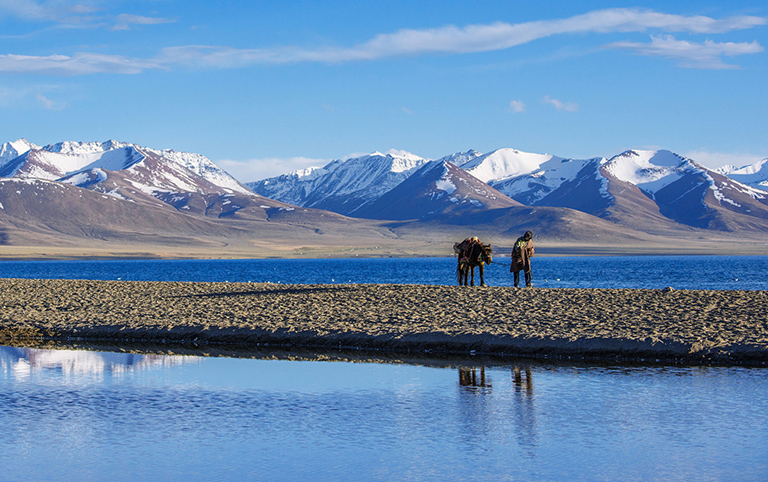 Splendid Landscape of Namtso Lake
Splendid Landscape of Namtso Lake
Day 10 Lhasa Departure ( B )
Today is free for you until your tour guide transfer you to the airport in time for your flight or drop you off at Lhasa train station.
Tips of Today: 1) please pack your luggage carefully, especially for small things like camera charger, power adaptor, mobile phone, phone charger, wallet and towel; 2) if your flight is arranged in the afternoon, please make sure you check out the hotel before 12pm.
Useful Trip Notes
-
- 1. Tibet Permits Guaranteed
To travel in Tibet, all Non-Chinese passport holders need to have a Tibet Travel Permit which is issued by Tibet Tourism Bureau in Lhasa. And only Chinese travel agencies like Tibet Discovery can apply for the permit on behalf of tourists. You must obtain it before your tour starting because the permit will be checked when you board your flight/train to Tibet. Traveling with Tibet Discovery, you don't have to worry about the complicated procedures of Tibet Travel Permit application. All you have to do is to confirm a tour package with us and send us your passport and Chinese visa copies at least 15~20 days in advance before your tour, then we will take care of all the rest things. Once the permit is issued, we will deliver to your address in China, such as your hotel, local travel agency, etc.
-
- 2. Available Months to Visit Tibet
Generally speaking, April to October is the best time. July and August are the peak season and rainy season. It is usually snowy and cold in winter, which is not suitable for visit Mount Everest, Namtso and Mount Kailash regions. While other places such as Lhasa, Gyantse and Shigatse are suitable for travel all year around. The temperatures in daytime and night differs a lot, usually 5~15℃ in the daytime and -5~0℃ in the night, so please wear accordingly.
-
- 3. High Altitude Sickness
The average altitude of Tibet is about 4000 meters above the sea level (Lhasa: 3700m; EBC: 5200m; Namtso: 4718m). You may suffer a bit from High Altitude Sickness in the beginning days of your Tibet trip if you haven’t had rich high plateau travel experience. But don’t worry too much, the high altitude can be acclimatized usually in 2~3 days. Our suggestion is to take a physical examination and get suggestions from your doctor, and also bring some medicines to prevent from High Altitude Sickness before your trip. While in Tibet, you should keep warm all the time, avoid strenuous activities, drink more water and eat more vegetables and carbohydrates. You’d better not take showers during the first two days after your arrival in Tibet. If you don’t feel well, get help from your tour guide or go to the hospital without any delay.
-
- 4. How to Go to Tibet
Basically you have two options – flight and train. Currently, you can take a flight to Lhasa from Beijing(4.5hrs), Xian(3.7hrs), Chengdu(2.5hrs), Chongqing(3hrs), Kunming(3hrs), Kathmandu (1.5hrs), etc. Among all these cities, Chengdu and Xian have more frequent flights to Lhasa.
If you prefer a train travel, you can take a train to Tibet from Beijing(40.5hrs), Xian(32hrs), Chengdu(43hrs), Shanghai(47hrs), Chongqing(42hrs), Lanzhou(25hrs), Xining(22hrs), Guangzhou(54hrs). -
- 5. Packing and Wearing Ideas
Firstly you can’t forget your passport and Chinese Visa. A large backpack and a smaller one are recommended (the smaller one can be used for daily activities). Also bring necessary medicine you need. Other stuffs like sunglasses, snow glasses, hats, lip balm, sun block are recommended.
As for wearing, you are suggested to dress in layers (both thin and thick jackets). Down jacket is necessary in Spring and Autumn. A pair of durable and comfortable shoes is necessary.
Recommended Tibet Group Tour Packages
Escorted by a skilled driver and companied by a professional local tour guide to organize all the activities, all you have to do is to enjoy your fantastic Tibet journey.Following are some other recommended Tibet group tour packages that you may be interested in. You can also contact us to customize a trip if you want..
-

Chengdu / Lhasa
7 Days Lifetime Tibet Train Tour from Chengdu
Highlights: Chengdu Panda Base, Qinghai Tibet Railway, Potala Palace
-

Chengdu / Lhasa
6 Days Classic Chengdu Lhasa Highlights Tour
Highlights: Panda Base, Wenshu Temple, Potala Palace, Sera Monastery
-
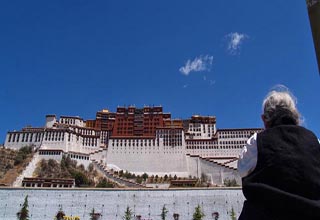
Chengdu / Lhasa
4 Days Best of Tibet Tour from Chengdu
Highlights: Highlights:Potala Palace, Jokhang Temple, Sera Monastery




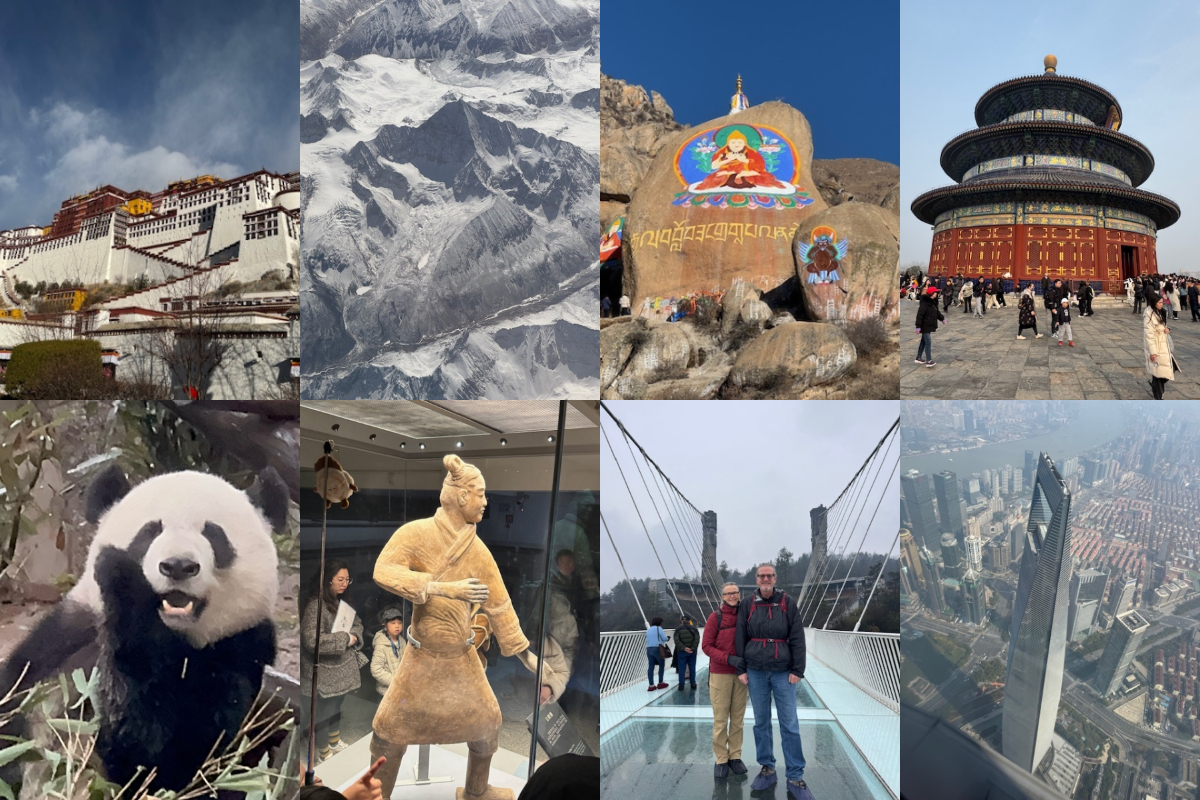


 Karen
Karen Wonder
Wonder Jack
Jack Rita
Rita Johnson
Johnson Vivien
Vivien Wing
Wing Ariel
Ariel Leo
Leo Tracy
Tracy Evelyn
Evelyn April
April Phoebe
Phoebe Kelly
Kelly Shirley
Shirley Reya
Reya Juliet
Juliet Elk
Elk Felix
Felix Sean
Sean